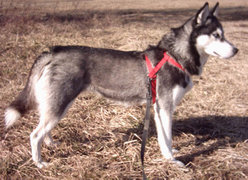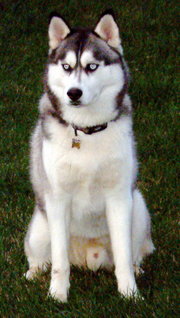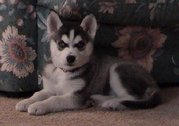
|
From Wikipedia the free encyclopedia, by MultiMedia |
| Siberian Husky | |
|---|---|

Four-year-old grey and white Siberian
|
|
| Alternative names | |
| Chukcha, Chuksha | |
| Country of origin | |
| Russia (Siberia) | |
| Common nicknames | |
| Siberian, Husky | |
| Classification and breed standards | |
| FCI: | Group 5 Section 1 #270 |
| AKC: | Working |
| ANKC: | Group 6 (Utility) |
| CKC: | Group 3 (Working) |
| KC (UK): | Working |
| NZKC: | Utility |
| UKC: | Nothern Breeds |
| Not recognized by any major kennel club | |
| This breed of Dog is extinct | |
| Notes | |
A working Dog breed that originated in eastern Siberia, the Siberian Husky is a medium-sized Dog, 35 to 60 pounds (16 to 27 kg) in weight, 20 to 23.5 inches (51 to 60 cm) in height, originally bred by the Chukchi tribes for use as a village Dog, herding the reindeer, pulling sledges, and guarding the women and children.
Siberians have a dense double-layer coat that comes in a variety of colours and patterns, usually with white feet and legs, facial markings, and tail tip. The most common colors are black and white, grey and white, copper red and white, and pure white, though many individuals have brown, reddish, or biscuit shadings and some are piebald spotted. Striking masks, spectacles, and other facial markings occur in wide variety.
Their eyes are brown, hazel, or blue. The light blue eye colour is characteristic but incompletely dominant. The breed may have one eye brown or hazel and the other blue, or may have blue and another colour mixed in the iris of one or both eyes; this latter trait is sometimes called "bi-eyed" by Siberian enthusiasts. This might be the only breed for which different-colored eyes are allowed in the show ring.
Its ears are triangular, well-furred, and erect; its fox-like brush tail is carried in a sickle curve over the back.
The Siberian Husky's coat consists of two layers, a dense, cashmere-like undercoat and a longer coarser topcoat consisting of straight guard hairs. Siberians usually shed their undercoat once or twice a year, producing prodigious quantities of fur; the process is commonly referred to as blowing their coat. Dogs that live primarily indoors often shed year round, so the shedding is less profuse—but constant. Therefore, an owner might have a Siberian that sheds lightly all year, or a Siberian that blows its complete coat twice a year. A strong steel comb helps in removing the dense handfuls of hair that come loose while the Dog is blowing its coat. Otherwise, grooming is minimal; bathing is normally unnecessary as the coat sheds dirt. Well and healthy Siberians have no odor.
 2-year-old male
2-year-old male
Popular as family pets and as show Dogs due to their striking appearance and gentle temperament, Siberians have certain drawbacks. Although normally quite tractable, affectionate and docile with people, they have a strong hunting drive and will kill cats, rabbits, chickens, squirrels and other birds and small animals; they have been known to savage sheep. They should be kept in secure enclosures as they will not always come to call and will often disappear on long hunting trips; they cannot be allowed to run loose. Siberians are also accomplished escape artists and diggers, so it is important to check enclosures frequently for any potential escape routes. Siberians are trainable to a certain degree, but patience is necessary. They are independent in nature and not given to blind obedience to every command.
 Seven-week-old Siberian
Seven-week-old Siberian
Siberians are normally rather healthy Dogs, living typically from eleven to fifteen years of age. Health issues in the breed are eye troubles (cataracts, glaucoma, and corneal dystrophy among others), allergies, and cancer in older animals. Hip dysplasia occurs but is not a major concern in the breed. This breed needs a high-quality diet with high levels of protein and fat, particularly when used for Dogsledding. That said, Siberian Huskies are rather fuel efficient Dogs, consuming less food than other Dogs of similar size and activity level. The diet must be adjusted to their level of work and exercise; obesity can be a problem for underexercised, overfed pets.
The Siberian Husky is widely believed to have originated exclusively with the Coastal Chukchi tribes of the east-Siberian peninsula. There is evidence, however, that Siberian Dogs were also imported from the Koryak and Kamchadal tribes. Recent DNA analysis confirms that this is one of the oldest breeds of Dog.[1] Dogs from the Anadyr River and surrounding regions were imported into Alaska from 1908 (and for the next two decades) during the gold rush for use as sledDogs, especially in the All-Alaska Sweepstakes (AAS), a 408 mile (657 km) distance Dogsled race from Nome to Candle and back. Smaller, faster and more enduring than the 100 120 pound (45 to 54 kg) freighting Dogs then in general use, they immediately dominated the Nome Sweepstakes.
Leonhard Seppala, a Norwegian fisherman turned gold miner, became involved with Siberian Dogs when he was asked by his employer to train a group of females and pups for the 1914 AAS. After a poor start his first year, Seppala dominated the races thereafter. In 1925 he was a key figure in the 1925 serum run to Nome which delivered diphtheria serum from Nenana by Dogsled after the city was stricken by an epidemic. The Iditarod trail race commemorates this famous delivery. The following year two groups of Seppala’s Dogs toured the USA, starting a mania for sledDogs and Dogsled racing, particularly in the New England states.
In 1930 the last Siberians were exported as the Soviet government closed the borders of Siberia to external trade. The same year saw recognition of the Siberian Husky by the American Kennel Club. Nine years later the breed was first registered in Canada. Today’s registered Siberian Huskies are largely the descendants of the 1930 Siberia imports and of Leonhard Seppala’s Dogs.
Siberians are still used occasionally as sledDogs in Dogsled racing but have been widely replaced by the more popular Alaskan Husky and hound-type crossbreds that are specially bred and selected for speed and have less heavy coats. Siberian Huskies were designed to pull a light load over long distances at a medium pace, and simply can't keep up with their faster counterparts. Siberians are still popular in races restricted to purebreds and are faster than other pure sledDogs breeds such as the Samoyed and Alaskan Malamute. Today the breed tends to divide along lines of “racing” Siberians versus “show” Siberians.
Apart from Dogsled racing, they are very popular for recreational mushing and are also used for skijoring (one to three Dogs pulling a skier) and European ski-pulka. A few owners use them for Dog-packing and hiking. They have also seen use as therapy Dogs.
Dogs, made by MultiMedia | Free content and software
This guide is licensed under the GNU Free Documentation License. It uses material from the Wikipedia.